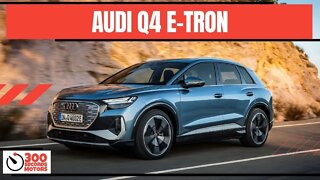Audi SQ2, can it be sporty? Standout star of the compact SUV
Striking design meets tremendously fun driving: Audi is presenting the SQ2 for the first time, the new top model of the Q2 family stands out in the compact SUV segment: It puts out 221 kW (300 hp), enough to sprint from 0 to 100 km/h (62.1 mph) in 4.8 seconds and a top speed of 250 km/h (155.3 mph). quattro all-wheel drive and the S sport suspension applies the power smoothly to the road. The Audi SQ2 is also at the head of its class with respect to operation, infotainment and assist systems.
0 – 100 km/h (62.1 mph) in 4.8 seconds: the engine
The heart of any Audi S model is the engine, and the 2.0 TFSI in the SQ2 (combined fuel consumption in l/100 km: 7.2 – 7.0*; combined CO2 emissions in g/km: 163 – 159*) is in peak form. It puts out 221 kW (300 hp) and a constant 400 Nm (295.0 lb-ft) of torque between 2,000 and 5,200 rpm. Developed by Audi engineers and built in Győr, the engine outclasses all its rivals in this segment. The same applies to the sport SUV’s performance: The sprint from 0 to 100 km/h (62.1 mph) takes 4.8 seconds, and top speed is a governed 250 km/h (155.3 mph).
The four-cylinder TFSI in the Audi SQ2 is a high-performance, 1,984 cc engine. It responds instantly up to the redline at 6,500 rpm. In the dynamic mode of the Audi drive select dynamic handling system, it responds even more directly, with brief double-clutching accompanying the gear changes by the S tronic. The engine develops a particularly sonorous sound when driven dynamically. The 2.0 liter TFSI engine weighs only around 150 kilograms (330.7 lb), which benefits not just the total weight of the Audi SQ2, but also the axle load distribution.
Numerous high-tech features hone the profile of the powerful four-cylinder. The intake and exhaust camshafts are adjustable to optimize fill and gas exchange. On the exhaust side, the Audi valvelift system (AVS) adjusts valve lift in two stages based on demand. This reduces flushing losses in the combustion chamber and ensures optimal flow of exhaust gas to the turbocharger, particularly in the low rpm range. The advantages of this are agile engine response and a further increase of torque. Controlled by a fast and precise electric overflow valve, the turbocharger develops its maximum boost of 1.4 bar (relative) very dynamically. This engine management system enhances efficiency and reduces fuel consumption during operation under part load.
Efficiency is also a major focal point with the 2.0 TFSI. Two electric-powered rotary valves consolidated into a module regulate the coolant flows. Another major component of the thermal management system is the exhaust manifold integrated into the cylinder head. It helps the engine to warm up quickly.
Targeted measures implemented in many components increase strength and reduce internal friction. The regulated oil pump requires little drive energy. Under part load, the engine management system deactivates FSI gasoline direct injection. Instead, fuel is injected indirectly into the intake manifold, which reduces particle emissions. A particle filter also cleans the exhaust gas.
Traction, stability and handling: the power transmission
A seven-speed S tronic with a high spread of 8.7 between the first and last gears transfers the power of the 2.0 TFSI. The driver can operate the lightning-fast dual-clutch transmission in the automatic modes D or S, or shift themselves. If the Audi drive select dynamic handling system is in “efficiency” mode, the clutch disengages when coasting, allowing the compact sport SUV to freewheel. From a residual speed of 7 km/h (4.3 mph), the engine already switches over to start-stop operation.
The seven-speed S tronic’s two clutches are in an oil bath. A small, mechanically driven gear pump supplies them with oil. At elevated demand, a second, electrically driven pump is activated. This efficient oil supply and the low friction of the individual components result in high efficiency.
As with every Audi S model, quattro all-wheel drive is standard in the SQ2. It combines high traction with fascinating handling. Its central element is a hydraulically actuated multi-plate clutch. It distributes torque continuously between the axles. If the front wheels lose grip, the multi-plate clutch can transfer up to 100 percent of the force to the rear within just a few milliseconds.
The quattro drive’s electronic controller provides for the ultimate in driving enjoyment and safety. During sporty driving, it can direct torque to the rear axle as soon as the driver turns the wheel. Under acceleration, the torque literally pushes the fast SUV into the curve. The quattro management system enables precise turn-in during load reversal, and provides maximum control and reliability when drifting on a low-friction road surface.
-
 5:00
5:00
300 Seconds Motors
1 year agoAUDI Q3 SPORTBACK 45 TFSI QUATTRO Compact Crossover with Athletic Prowess - Pulse Orange
1391 -
 5:00
5:00
300 Seconds Motors
2 years agoThe new AUDI RS3 SPORTBACK unmatched sportiness suitable for everyday use
29 -
 5:00
5:00
300 Seconds Motors
3 years agoAUDI Q4 SPORTBACK E-TRON INTERIOR electric SUV in the premium compact segment
12 -
 5:00
5:00
300 Seconds Motors
2 years ago $0.03 earnedThe new AUDI RS3 SEDAN unmatched sportiness suitable for everyday use
45 -
 5:00
5:00
300 Seconds Motors
3 years agoAUDI Q4 SPORTBACK E-TRON electric SUV in the premium compact segment
40 -
 1:50
1:50
CAR TV
1 year agoBMW X7 Alpina (2023) 630-HP Luxury SUV
42 -
 18:40
18:40
MikesCarInfo
11 months ago $0.02 earned👉2024 VW Atlas Cross Sport SE W/Tech Volkswagen -- Detailed Look
65 -
 5:00
5:00
300 Seconds Motors
3 years agoThe interior of AUDI Q4 E-TRON first purely electric car in SUV compact segment from the brand
20 -
 6:46
6:46
CARTV1
1 year agoAudi RS7 (2022) - Wild Luxury Coupe!
47 -
 5:00
5:00
300 Seconds Motors
3 years agoNew AUDI Q4 E-TRON first purely electric car in SUV compact segment from the brand
44